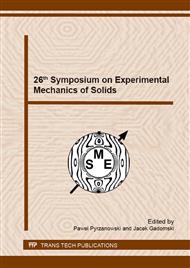[1]
M. Brännström, O. Vojinovič, Response of the dental pulp to invasion of bacteria around three filling materials, J Dent for Children 43 (1976), pp.15-21.
Google Scholar
[2]
C.L. Davidson, A.J. Feilzer, Polymerization shrinkage and polymerization shrinkage stress in polymer-based restoratives, J Dent., 25(1997), pp.435-440.
DOI: 10.1016/s0300-5712(96)00063-2
Google Scholar
[3]
R.R. Braga, J.L. Ferracane, Alternatives in Polymerization Contraction Stress Management, Crit Rev Oral Biol Med, 15(2004), p.176 – 184.
Google Scholar
[4]
J.L. Ferrance, Resin composite – state of the art, Dental Materials 27 (2011), p.29 – 38.
Google Scholar
[5]
C.J. Kleverlaan, A.J. Feilzer, Polymerization shrinkage and contraction stress of dental resin composites, Dental Materials 21 (2005), p.1150 – 1157.
DOI: 10.1016/j.dental.2005.02.004
Google Scholar
[6]
M. Domarecka, J. Sokołowski, et al., Shrinkage stresses of dental composites (in Polish), proceed. XIV Conf. Biomaterials and Mechanics in Dentistry, Ustroń 2014, p.33.
Google Scholar
[7]
R.L. Sakaguchi, J.M. Powers, Craig's Restorative Dental Materials, 13th ed., Elsevier Mosby, Philadelphia, USA, (2012).
Google Scholar
[8]
G. Milewski, Strength aspects of biomechanical interaction bone-implant in dentistry (in Polish), DSc thesis, Cracow Univ. Technology Publish., Cracow, (2002).
Google Scholar
[9]
L. Giachetti, et al., A review of polymerization shrinkage stress: current techniques for posterior direct resin restorations, J Contemp Dent Pract. 7 (2006), pp.79-88.
DOI: 10.5005/jcdp-7-4-79
Google Scholar
[10]
R.R. Braga, J.L. Ferracane, T.J. Hilton, Contraction stress of flowable composites and their efficacy as stress-relieving layers, J Am Dent Assoc 134(2003), pp.721-728.
DOI: 10.14219/jada.archive.2003.0258
Google Scholar
[11]
M.H. Chen, et al., Low shrinkage light curable nanocomposite for dental restorative material, Dental Materials 22 (2006), p.138 – 145.
DOI: 10.1016/j.dental.2005.02.012
Google Scholar
[12]
J.R. Condon, J.L. Ferracane, Reduced polymerization stress through non-bonded nanofiller particles. Biomaterials 23(2002), pp.3807-3815.
DOI: 10.1016/s0142-9612(02)00099-6
Google Scholar
[13]
S. Uno, E. Asmussen, Marginal adaptation of a restorative resin polymerized at reduced rate. Scand J Dental Research 99 (1991), pp.440-444.
DOI: 10.1111/j.1600-0722.1991.tb01052.x
Google Scholar
[14]
G. L. Unterbrink, R. Muessner, Influence of light intensity on two restorative systems, J Dent. 23 (1995), pp.183-189.
DOI: 10.1016/0300-5712(95)93577-o
Google Scholar
[15]
B.S. Lim, J.L. Ferracane, R.L. Sakaguchi, J.R. Condon, Reduction of polymerization contraction stress for dental composites by two-step light-activation, Dental Materials 18 (2002), p.436–444.
DOI: 10.1016/s0109-5641(01)00066-5
Google Scholar
[16]
N. Emami, K.J.M. Söderholm, L.A. Berglund, Effect of light power density variations on bulk curing properties of dental composites, J Dent. 31 (2003), p.189 – 196.
DOI: 10.1016/s0300-5712(03)00015-0
Google Scholar
[17]
Ch. M. Kemp-Scholte, C. L. Davidson, Marginal integrity related to bond strength and strain capacity of composite resin restorative systems. J Prosth Dentistry, 64 (1990), pp.658-664.
DOI: 10.1016/0022-3913(90)90291-j
Google Scholar
[18]
Ch.M. Kemp-Scholte, C.L. Davidson, Complete marginal seal of class V resin composite restorations effected by increased flexibility, J Dental Research 69 (1990), pp.1243-1249.
DOI: 10.1177/00220345900690060301
Google Scholar
[19]
R.R. Braga, J.L. Ferracane, J.R. Condon, Polymerization contraction stress in dual-cure cements and its effect on interfacial integrity of bonded inlays, J. Dent 30 (2002), pp.333-340.
DOI: 10.1016/s0300-5712(02)00047-7
Google Scholar
[20]
A.E. Oden, K.M.G. Andersson, Methods of making artificial tooth onlays and inlays, U.S. Patent 5, 106, 303 (1992).
Google Scholar
[21]
D. Alster, A.J. Feilzer, A.J. de Gee, C.L. Davidson, Polymerization contraction stress in thin resin composite layers as a function of layer thickness, Dental Materials 13(1997), p.146–59.
DOI: 10.1016/s0109-5641(97)80115-7
Google Scholar
[22]
J.R. Condon, J.L. Ferracane, Assessing the effect of composite formulation on polymerization stress, J Am Dent Assoc 131(2000), p.497–503.
Google Scholar
[23]
www. micerdent. pl/index. php.
Google Scholar


